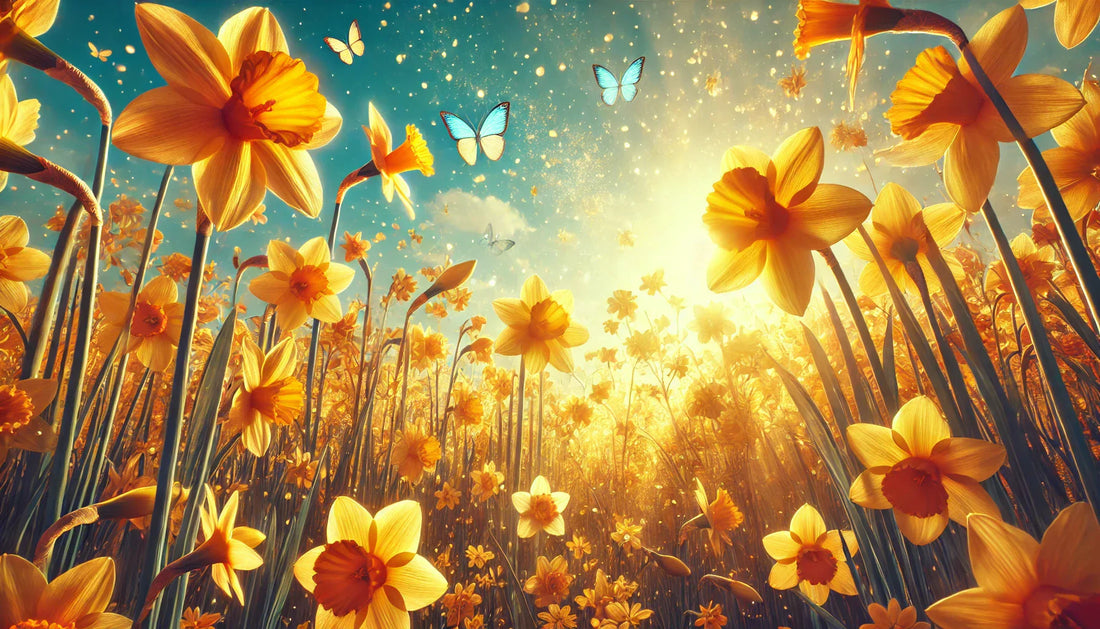
Daffodils: The Golden Herald of Spring
Cody ManesShare
A Bloom of Sunshine: Introduction to Daffodils
Daffodils, with their bright yellow, white, or orange petals, are one of the most beloved harbingers of spring. Scientifically known as Narcissus, these cheerful flowers have captivated humans for centuries with their beauty, resilience, and rich symbolism. Associated with renewal, hope, and the changing of seasons, daffodils are more than just a visual delight—they carry deep spiritual and mythological significance. Whether found blooming in wild meadows or carefully cultivated in gardens, daffodils remind us of the cycle of rebirth and the promise of warmer days ahead.
The History and Mythology of Daffodils
The history of daffodils dates back thousands of years, with records of their existence in ancient civilizations such as Greece, Rome, and Egypt. The flower's botanical name, Narcissus, comes from Greek mythology. According to legend, Narcissus was a handsome young man who became so enamored with his own reflection in a pool of water that he ultimately wasted away, transforming into the delicate flower we now call the daffodil. This tale has led to associations of daffodils with themes of self-love, vanity, and spiritual introspection.
In ancient Rome, daffodils were highly valued and were often planted in gardens or used to create floral garlands. The Romans even believed that daffodils had healing properties and could be used to treat wounds. Later, in medieval Europe, daffodils became symbolic of renewal and hope, representing the arrival of spring after long, harsh winters. Today, they continue to be associated with new beginnings and are often gifted to mark fresh starts in life.
Spiritual and Symbolic Meaning of Daffodils
Daffodils are deeply connected to themes of rebirth, transformation, and personal growth. Their early bloom signals the end of winter, making them powerful symbols of hope and perseverance. Many spiritual traditions view daffodils as representations of positivity, new opportunities, and fresh perspectives.
In some cultures, daffodils are believed to bring good fortune and prosperity. In China, they are often associated with the Lunar New Year, symbolizing good luck and success in the year ahead. In Western traditions, daffodils are frequently given as gifts to celebrate milestones such as new jobs, home purchases, or personal achievements, reinforcing their meaning of fresh starts and optimism.
Emotional and Mental Benefits of Daffodils
Flowers have long been known to have a profound impact on emotions, and daffodils are no exception. Their bright, sunny hues are naturally uplifting, making them a great choice for boosting mood and warding off feelings of sadness or fatigue. The mere presence of daffodils in a home or workspace can bring a sense of warmth, happiness, and encouragement.
Beyond their visual appeal, daffodils also symbolize resilience and inner strength. Their ability to bloom early in the season, sometimes even through frost, serves as a reminder that challenges can be overcome and that brighter days are always ahead. Whether given as a gift or enjoyed in a garden, daffodils serve as a natural source of encouragement and motivation.
Healing and Protective Qualities of Daffodils
While daffodils are more commonly known for their symbolism and beauty rather than their medicinal properties, they have been used in folk remedies for centuries. However, it is important to note that daffodils contain toxic alkaloids, making them unsafe for direct consumption. In ancient times, extracts from daffodils were used in small doses to treat respiratory ailments, wounds, and even pain relief. Today, modern research has investigated the potential of daffodil compounds in cancer treatment, particularly in targeting certain types of leukemia cells.
Beyond physical healing, daffodils are also believed to offer energetic protection. Some spiritual practitioners use daffodils in rituals for cleansing negative energy and attracting positive vibrations. Placing fresh daffodils in the home is thought to promote harmony and dispel negativity, while dried daffodil petals may be used in sachets or charms for protection and renewal.
Practical Uses and Applications of Daffodils
Daffodils are versatile flowers that can be used in a variety of ways beyond their decorative appeal. Their bright blooms make them a favorite choice for floral arrangements, bouquets, and garden displays. In landscaping, daffodils are often planted in clusters to create vibrant bursts of color, adding life and charm to any outdoor space.
For those who enjoy crafting, dried daffodil petals can be incorporated into potpourri, pressed flower art, or even homemade greeting cards. Additionally, daffodils are a popular motif in art and literature, frequently appearing in poetry, paintings, and folklore as symbols of beauty, hope, and inspiration.
Caring for Daffodils: Tips for Longevity
Daffodils are relatively easy to care for, whether growing in a garden or displayed in a vase. When planting daffodil bulbs, it is best to do so in the fall before the first frost. They thrive in well-draining soil and prefer full sunlight to partial shade. Once established, daffodils require minimal maintenance and will return year after year, bringing their cheerful presence to your garden each spring.
For cut daffodils, it is important to handle them carefully, as they release a sap that can be harmful to other flowers in mixed arrangements. To extend their vase life, trim the stems at an angle under running water and place them in a clean vase with fresh water. Changing the water every two days will help keep them looking vibrant for longer.
The Lasting Beauty of Daffodils
Daffodils are more than just beautiful flowers; they are symbols of renewal, joy, and perseverance. Their presence in gardens and homes brings warmth and optimism, serving as a reminder that even after the darkest winters, light and life will return. Whether admired in nature, given as a heartfelt gift, or used in spiritual practices, daffodils continue to inspire and uplift all who encounter them.
As the golden heralds of spring, daffodils encourage us to embrace change, welcome new beginnings, and celebrate the beauty of the present moment. Their radiant blossoms and enduring spirit remind us to remain hopeful, no matter the challenges we face. So the next time you see a daffodil, take a moment to appreciate its simple yet profound message: brighter days are always ahead.
Ready for more? Dive into our next topic: Lilies
